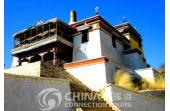Wudangzhao Lamasery
- Things to do
-
- Photo(10)
- Tips&article(3)
- Make it Happen
- Map
-
loading...
- Other Tours
Wudangzhao Lamasery is the largest and best-preserved Tibetan Lamasery in Inner Mongolia. It is located 70 km (44 miles) northeast from Baotou City, at Wudanggou Valley surrounded by mountains.
Wudangzhao was built in 1749, and was modeled after Tashilhunpo Lamasery in Shigatse, Tibet. Wudang means willow, and Zhao means lamasery in Mongolian language, this is because willows were luxuriant in the valley at that time. Wudangzhao has a Tibetan name Bada Gele, meaning white lotus. In the year of 1756, the then Emperor Qianlong of Qing Dynasty bestowed a Chinese name on the Lamasery – Guangjue Si (Guangjue Temple).
The lamasery is a group of traditional Tibetan architecture with white walls and flattened roofs, dotted about at the mountain slope of 1 mile long, covering an area of about 50 acres. The construction layout is quite unique. Usually temples are built like courtyards with enclosing walls. However, buildings of Wudangzhao adopt an open layout, with each building being independent and distributed irregularly at the mountain slope and the valley.
Buildings center around six main halls, which form six complexes, with three living Buddha residences, one funeral hall for storing ashes of the living Buddhas in the past, and many residences for monks.
The three-floor Suguqin Hall is the main hall and the largest in the lamasery. This is the main assembly hall where all the monks gather to chant sutras or have meetings. According to statistics, there are over 150,000 Buddhist statues at Wudangzhao, with sizes rang from several meters tall to inches small, made of materials like gold, copper, wood and even mud.
There is also a large collection of Buddhist arts in the lamasery vividly depicting folklores, figures, animals and plants as well as Buddhist stories, which provide precious resources for studies of Tibetan, Mongolian ethnic religions and culture.
Since 1763, there have been seven living Buddhas at Wudangzhao, and the last one died in 1955. Their ashes were stored in the funeral hall. In its prime time, there were over 1,200 monks at Wudangzhao. Besides for Buddhist activities and pilgrimage, Wudangzhao is a famous lecturing lamasery in Inner Mongolia. It has schooling for monks to learn sutras and study Buddhism.
Among the many Buddhist activities here, the most popular one has to be the temple fair. Every year from July 25 till August 1 on lunar calendar, all the monks at Wudangzhao will chant sutra at Suguqin Hall. At dusk, the monks will walk around the lamasery holding prayer wheels, blowing religious pipes and beating sheepskin drums. Pilgrims and tourists all gather here to watch this magnificent scene and take part in the celebrating activities.
Tips & articles
|
|
|










